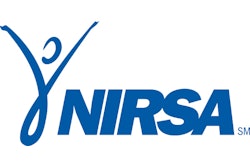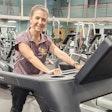The right risk-management plan makes all the difference in climbing wall safety.

On Nov. 10, 1998, a climber at San Diego State University's Aztec Recreation Center tied into a rope incorrectly and fell 30 feet to the ground.
At the same facility, on Feb. 18, 1999, a climber-not on belay and not communicating properly with his belayer-also fell from the climbing wall. Since those two incidents, the center has put into place an orientation program, including a test-to be given to every climber, with no exceptions-in order to ensure a safer climbing environment.
Although it is impossible to eliminate all climbing wall risks, a climbing wall can be a safe adventure for all involved if its use is controlled and if proper risk-management strategies are implemented. "There are just too many safety factors involved when gravity is part of the experience," says Glenn Town, director of the sports and recreation complex at Wheaton College in Illinois. "You've got to make sure they are all in place. Otherwise, it's not going to work. It's going to be a problem-a dangerous problem."
Bob Garmirian, director of athletics in the outdoors program at Hampshire College in Amherst, Mass., has supervised and implemented safety measures for his recreation center's climbing wall for several years. "Having a safe climbing wall is about having standards," he says. "It's about applying those standards judiciously and uniformly. If you've got 100 people on the wall, those guidelines have to apply 100 times. It's not anything too complex; it's just making sure you apply your standards with each participant."
The Climbing Wall Industry Group (CWIG) Standards, which are used in climbing wall engineering and design, were first established in 1993. (The CWIG is a subgroup of The Outdoor Recreation Coalition of America. ORCA works to provide resources for the outdoor industry, while its climbing specialty groups focus on specific needs within the climbing industry.) The CWIG standards are under revision and are in the process of being established by the American Society for Testing and Materials (ASTM), which is expected to approve them before year's end.
"The quandary that we're up against at the board level right now is that the standards that we've set are almost too high," says Shannon Sunderland, program coordinator for ORCA. "We say that the wall has to hold 7,500 pounds. So now we're trying to figure out how much weight the heaviest person climbing in the most extreme way could really generate." Sunderland adds that the CWIG board of directors-which is made up of numerous wall manufacturers who have been veterans of the industry since it gained a foothold in the United States-has been discussing whether to hire an outside, neutral party to determine if the standards are too lofty.
Ian Glas, project manager and designer at Monolithic Sculptures, a Denver, Colo.-based company that designs and builds climbing walls, agrees that the CWIG standards seem to be a bit high. "We adhere strictly to the CWIG standards," says Glas. "They're overdone quite a bit, but you can be sure that you're pretty darn safe on a climbing wall if a climbing wall company adheres to the CWIG's policies."
Glas points out that when designing a wall, it is not only important to take into account the weight a wall can hold, but it is also necessary to carefully analyze the angles of the climbing wall to consider where it is possible for gravity to take human beings. Once that is determined, the designer must calculate the amount of space needed around the wall to accommodate any possible falls. "And on a more minor note," Glas adds, "people can injure their hands while climbing. The holds have to be comfortable and tendon-friendly.
It should be noted that some climbing wall companies-including Monolithic Sculptures-use a new sculpting design that creates natural routes on the wall and eliminates the need for holds. Wall operators can decide whether to use bolted-on holds that are provided with the wall or to go without them, allowing climbers to experience the challenges they would face in an outdoor setting.
Since climbers do occasionally fall, an important safety consideration is the type of landing material a facility will use at the base of its climbing wall. Designers and planners need to determine this for themselves, as there is no existing industry standard for landing material. Issues such as height, difficulty and whether the wall is indoors or outdoors will affect what landing material is used. At the outdoor climbing and bouldering walls at James Island County Park in Charleston, S.C., the 8-inch-deep landing material consists of pea gravel. The climbing wall is 50 feet tall, and the bouldering wall reaches 10 feet. The 33-foot-high indoor climbing wall at Colgate University in Hamilton, N.Y., has a 2-inch-thick wrestling mat for a landing pad.
The safety of the climbing wall equipment is also an issue that climbing wall managers and supervisors should prepare for when devising a risk-management plan. Many facilities provide all climbing equipment so that they can check it themselves on a regular basis to verify that it's still safe to use. At Colgate University, climbers can bring in all their own equipment except ropes, and supervisors check all gear coming in to make sure it's safe. Colgate still provides all the other needed equipment-including floor anchors, webbing, carabiners, helmets, harnesses and shoes-for climbers who do not have their own.
Once the more technical aspects of a climbing wall risk-management plan are in place, several other strategies can be implemented to further reduce the risk of injury. One of the most important is controlling access to the climbing wall during both open and closed hours. "The best way to control the situation is to only allow people to climb the wall if you've decided they are capable of participating," says Garmirian.
In order to limit access to the wall during open hours, ongoing supervision is imperative-not only to keep unqualified climbers off the wall, but also to make sure that the qualified climbers are behaving appropriately. "Supervisors need to be present even for those climbers who have the climbing knowledge," says Garmirian. "They have to be there to make sure that 17- year-old Harry, who's just gotten out of high school for the day and is all wound up, is not doing something foolish or that he's not teaching his buddy the wrong technique."
At Hampshire College's recreation facility, even students who are exceptional climbers are not allowed to supervise the climbing wall. "It's not that they don't have the experience and the knowledge," says Garmirian, "but it's difficult to be mature enough to tell your peers, 'Don't do that,' or 'That's not safe.' A big part of controlling the situation is having the supervisors be mature adults with a sense of responsibility."
The other task of a climbing wall supervisor is to allow only qualified climbers onto the wall. The exact skills required of a climber depend upon the standards of the individual facility. Many facility operators physically test people when they come in, and when climbers pass the test, supervisors give them a membership card or keep track of their names for future reference.
Town planned his risk-management strategy long before Wheaton's climbing wall was installed in January. He requires people to pass a belaying test before they can climb the wall, and he also believes in the necessity of constant supervision during open hours. At Wheaton, a climbing supervisor and climbing instructors are present at all times when the climbing wall is operational. Limiting access during closed hours is just as vital.
At Wheaton's facility, the climbing wall is one of the four walls surrounding a volleyball and basketball court. The pad that the climbers land on is also the pad that, when put in a vertical position, covers the climbing wall and protects volleyball and basketball players from injuring themselves when colliding with it. And, Town adds, it's part of his security system for the wall to prevent people from climbing on it during closed hours.
The climbing wall at Colgate is even easier to keep off limits after hours. It is built into a renovated squash court, so the door to the room can be closed and locked when the wall is not open for use. The only people who have access to the wall are the directors and the 45 students on Colgate's outdoor education program staff. All staff members have received seven months of training in leadership and risk management and have also been belay-certified by the directors. The climbing wall room is housed in the university's gymnasium, and each staff member has access to the court's key and can use the climbing wall when the gym is open.
To help deter people from having a clear view of the walls and climbing on them during off hours, the walls at James Island County Park are intentionally set far back into the woods of the park and separated from the surroundings with fencing. Although this is not a foolproof plan, Wendy Stanley, the outdoor recreation specialist and climbing wall manager at the park, says that it's about all that can be done to prevent access to outdoor walls.
Like the climbing walls at Hampshire and Wheaton Colleges, James Island County Park's climbing and bouldering walls have constant staff supervision during open hours. Staff is always on hand ready to belay anyone who shows up and wants to climb, but climbers cannot belay anyone without taking a belay class. Since the staff is always present when the walls are open, belay classes can be provided whenever necessary.
Supervisors must also be aware of the age of participants at all times to know which ones should be wearing helmets. Although there are no set industry standards stating whether helmets must be worn, many facilities require that helmets be worn by climbers under the age of 18. "A lot of people have different viewpoints on that," says ORCA's Sunderland. "It's actually quite a contentious issue." At Colgate University's climbing wall, climbers under the age of 18 must wear a helmet, while those 18 years of age or older are required to sign a helmet waiver form if they don't want to wear one.
Liability waivers, whether for helmets or just for climbing on the wall, are an established practice in the climbing wall industry. Before a climber signs a waiver, he or she must be made aware of the safety rules and guidelines of that particular facility. Whether the rules are stated on the form or expressed in facility signage, all participants must sign as an indication that they have read, understood and accepted all rules. Colgate's wall is an example of a facility that is very persistent in making its rules well known.
The house rules are not only posted throughout the room, but the supervisors also verbally explain the rules to all new participants.
Like the posted house rules, a waiver can be used not only to protect the facility from a lawsuit, but also as another way to establish a clear line of communication with the participant. A well-written liability waiver will warn climbers of the risks involved in climbing, as well as identify that they are responsible for their own safety. It will also give the facility the right to order the climbers off the wall if they don't follow the safety rules and guidelines. Climbers also waive their rights to sue the facility owner for any negligence on the part of that facility. Of course, a waiver cannot require climbers to waive their rights against gross negligence or willful acts.
After physically implementing all of the aforementioned safety practices, a climbing wall supervisor can also utilize a more theoretical approach. Evaluating each climber, a supervisor can attempt to determine which climbers are at the most risk for an accident, and try to keep a closer eye on those climbers. "We deal with a continuum that's based on climbing experience and age," Garmirian says. "Those two variables put climbers somewhere on the continuum for how much risk they can assume. For example, with young kids, we figure they assume no risk. But if someone's 25 or 30 years old and has a huge amount of experience, we know that he or she has seen what can happen when something is done incorrectly, and we determine that that person can assume a large amount of risk."
Wheaton College's Town agrees with the continuum concept. "You have to identify your population," he says. "If you're building a climbing wall for a park district, it probably needs to be built with young kids in mind. In college students, I'm looking at climbers with a much higher degree of ability. I'm looking at taller and stronger individuals." If supervisors are able to assess each climbing wall participant for possible risk, they can be more aware of the potential dangers in any given situation, and they will have a better chance of anticipating potential problems.
It is also important for supervisors to know the age and experience of a climbing wall's user population because it helps planners determine the degree of difficulty and the levels of progression they will build into their wall. "You always have to make sure there's a careful progression of difficulty on the wall," Town says, "because even little kids become fine climbers, and they can get very bored with the wall if it doesn't challenge them."
A climbing wall can be a challenge both for the climbers and for the facility operators and supervisors, but it can also be fun. "A climbing wall can be a very safe recreational activity as long as people are trained right," says Josh Baker, co-director of Colgate's outdoor education program. "If people get in there and don't have the skills, then you're asking for trouble."




































